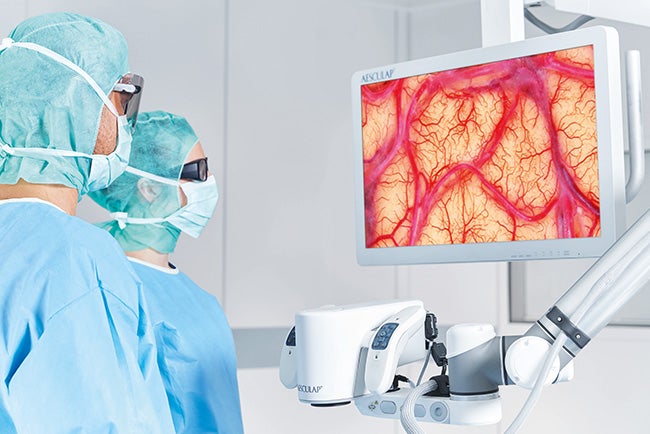Intro
Pioneering robotic-assisted digital platform
Every day, in every hospital, a balance must be found and maintained between conflicting needs of different parties – the quality and safety of patient care must be ensured while also bearing in mind the demands for cost efficiency. Furthermore, it is important to offer a favorable working environment for physicians, nurses and the other hospital staff.
This is especially true for neurosurgery departments. There, the availability of reliable, high-quality equipment is paramount for the neurosurgeons to perform their delicate work under supreme conditions. Undoubtedly, the microscope is a cornerstone for the neurosurgeon’s success.
We are dedicated to drive innovation forward, towards even better healthcare, with developments such as our Digital Surgical Microscope Platform. The Aesculap Aeos® is a sustainable investment into the future of neurosurgery. It allows the neurosurgeon to see more and to stand tall.
Vision
Seeing more thanks to improved digital imaging
Perfect vision is essential for the neurosurgeon. For many decades, optical surgical microscopes have served neurosurgeons worldwide well – but they do have certain limitations, such as a relatively small field of view, a short depth of field, illumination leading to frequent manual interactions for repositioning, refocusing and readjustment These interruptions are inefficient: The workflow is disrupted, hazardous situations may occur, and surgery time is prolonged by up to 10%. [1] Furthermore xenon illumination generates heat and may hence cause tissue damage and skin burns. In addition, xenon lamps need to be replaced after just 500 working hours, causing additional expenses and thus significant running costs.
The Aesculap Aeos® can provide the solution to many of these limitations. A superior Depth of Field as well as an extended Field of View and superior coaxial, cost-efficient LED illumination enable the neurosurgeon to see more at a glance without distracting interactions. Therefore our platform contributes to boosting efficiency, reducing risks like tissue damage and decreasing costs.
Find out more about how the Aesculap Aeos® helps the neurosurgeon to see more.
Ergonomics
Standing tall thanks to improved ergonomics
Conventional technology forces the neurosurgeon to bend over the eyepiece of the microscope for many hours. It is therefore estimated that 80% of neurosurgeons suffer from pain while operating. [2] Neck and back pain may in consequence affect the neurosurgeon’s performance, quality of life and health. An efficiently run neurosurgery department should not be affected by bad ergonomics and the consequences of such working conditions. The Digital Surgical Microscope Platform enables the neurosurgeon to stand tall while performing the surgery, resulting in a more natural, more comfortable position.
Learn more about how the Aesculap Aeos® helps the neurosurgeon to stand tall.
Efficiency
Improved efficiency thanks to our robotic-assisted Digital Surgical Microscope platform
To see more and to stand tall – these are not the only benefits of the Aesculap Aeos® that offer the potential for better efficiency in the operating room.
The robotic arm of our Digital Surgical Microscope for example enables the surgeon to conveniently position the camera hands-free and help to save valuable time by reducing the amount of work that is not directly related to the surgery. The neurosurgeon can therefore truly focus on his delicate task.
Last but not least, the Aesculap Aeos® is designed for increased upgradeability. New software elements can always be implemented and software can constantly be updated. This ensures that the neurosurgeon can use state-of-the-art technology, making the Aesculap Aeos® a forward-looking digital platform!
Do you want to learn more about the Aesculap Aeos® and how it can provide an added value to your neurosurgery department? Please feel free to contact us. We will be happy to provide you with all the information you need.
[1] Eivazi S, Afkari H, Bednarik R, Leinonen V, Tukiainen M, Jaaskelainen JE. Analysis of disruptive events and precarious situations caused by interaction with neurosurgical microscope. Acta Neurochir. 2015;157(7):1147-54.
[2] Soueid A, Oudit D, Thiagarajah S, Laitung G. The pain of surgery: pain experienced by surgeons while operating. Int J Surg. 2010;8(2):118-20.




